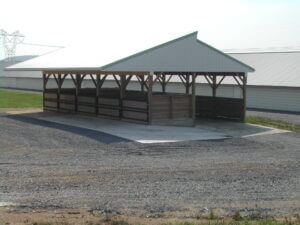Best Management Practices
Preventing or reducing sediment and nutrient pollution from farm operations
Best management practices (BMPs) are structural and agronomic methods that have been determined to be the most effective, practical means of preventing or reducing sediment and nutrient pollution from farm operations.
LCCD and NRCS staff are available to work with landowners and operators to help identify areas of concern. Once identified, staff will discuss possible BMP solutions, as well as prepare engineered designs as needed. During the construction phase, staff will provide quality assurance to ensure proper installation of BMPs.
Click the button below to view and download the PDF.
Structural BMP’s
Animal Mortality Facility
A facility for the treatment or disposal of livestock and/or poultry carcasses for normal and catastrophic animal mortality. Reduces impacts to water resources, minimizes odor, and decreases the spread of pathogens.
Animal Mortality Facility Code 316 PDF

Animal Trails & Walkways
A travel lane to provide livestock with a stabilized walking surface to reduce erosion, provide access to forage, and improve grazing distribution.
Animal Trails and Walkways Code 575 PDF

Diversions
A channel constructed across the slope to intercept and divert surface water away from farmsteads, agricultural waste systems, and other improvements.
Grassed Waterways
A shaped and graded vegetated channel established to reduce gully erosion and/or convey runoff from terraces, diversions, or other areas of water concentrations to a stable outlet.

Liquid Manure Storage
A concrete or lined earthen structure to temporarily store manure and barnyard runoff until crop conditions allow for spreading.
Waste Storage Facility Code 313 PDF

Roof Runoff Structures
A structure to collect, control, and convey precipitation runoff from roofs. This will protect surface water quality by excluding roof runoff from livestock areas. Typically this system consists of roof gutters and downspouts with a stable outlet.
Roof Runoff Structure Code 558 PDF

Stream Crossings
A stabilized area or structure constructed through a stream to provide a travel way for people, livestock, equipment, or vehicles. Reduces stream-bank/stream bed erosion and improves water quality.

Stream Fencing
Fencing installed along a stream to limit livestock access to streams or riparian areas.
Streambank Stabilization
Vegetation, structures, and/or cutting of the stream-bank to stabilize the banks from scour and erosion, and maintain or increase flow capacity.
Streambank Protection Code 580 PDF

Terraces
An earth embankment constructed across the field slope to intercept runoff water and reduce erosion. Gradient terraces outlet to waterways or diversions. Pipe-outlet terraces are graded to a riser pipe and outlet below the crop field.

Agronomic BMP’s
Conservation Crop Rotation
Growing crops in a planned rotation for bio-diversity, plant pest management, and to provide adequate amounts of organic material to reduce sheet and rill erosion and balance plant nutrients.
Residue Management – No-till
Planting crops directly into prior crop residues or cover crop with minimal or no tillage, to increase soil quality and surface residue, reduce sheet and rill erosion, and increase plant-available moisture
Residue and Tillage Management , No-Till 329

Contour Buffer Strips
Narrow strips of permanent, herbaceous vegetative cover established across the slope and alternated down the slope with parallel, wider cropped strips that are farmed on the contour, to reduce sheet and rill erosion.
Contour Buffer Strips Code 332 PDF
Contour Farming
Performing tillage, planting, and other farming operations on or as close to the contour as practical to reduce sheet and rill erosion, to reduce transport of sediment, and other waterborne contaminants.

Cover Crops
Crops including close-growing grasses, legumes, and small grains grown to provide ground cover when crop residues have been removed and winter soil protection is needed to reduce sheet and rill erosion.

Pasture Management
Managing grazing or browsing animals in order to improve the health and vigor of the pasture’s forage stand. Stocking rates, size of animals, resting periods, and seasonal changes all impact the conditions of a pasture.
Prescribed Grazing Code 528 PDF

Residue Management, Reduced Till
Managing the amount, orientation, and distribution of crop and other organic residue on the soil surface by using mulch tillage techniques and implements such as chisels, sweeps and harrows.
Riparian Buffers
Area of grass, trees and/or shrubs adjacent to streams, ponds, and wetlands. Increased vegetative cover creates shade to lower water temperatures and improves riparian habitat for wildlife, while also reducing excess amounts of sediment, organic material, nutrients and pesticides reaching the water body.
Strip-Cropping
Growing crops in contoured strips so that protective strips of grass or close growing crops are alternated with strips of row crops.
Lancaster County
Conservation District
1383 Arcadia Road
Room 200
Lancaster, PA 17601
Business Hours
Monday through Friday
7:30am-4:00pm
Phone:
(717) 299-5361 ext. 5
Fax:
(717) 299-9459
Follow us:
Copyright © Lancaster County Conservation District | All rights reserved. | Website by Albright Design Studio LLC
Financial support for website design provided by Arconic Foundation

